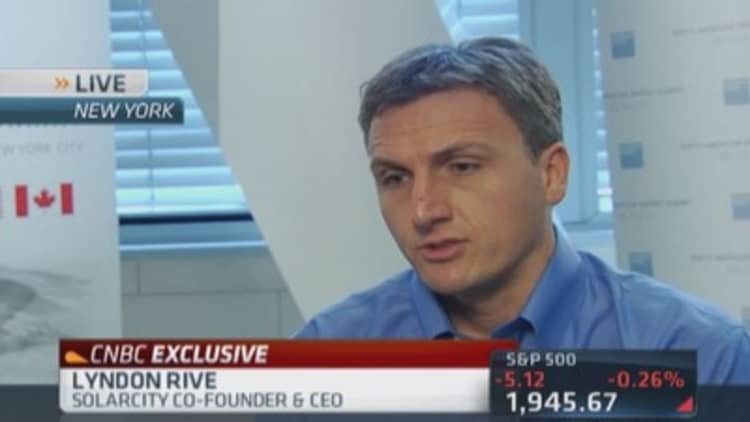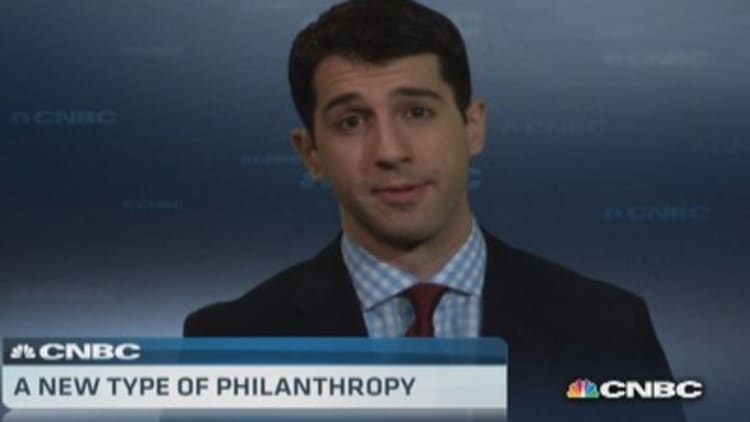The growth of the green bond market has set off the latest race for a scarce global resource: green bonds.
Green bonds—otherwise known as climate bonds—which primarily finance energy-related projects, are being issued in ever greater numbers. So far this year, more than $19.9 billion in green bonds have been issued worldwide, compared with $10.9 billion for all of 2013. By year-end 2014, that number is slated to be $40 billion, according to the Climate Bonds Initiative. (Even less aggressive estimates call for big growth—HSBC is projecting a market of $25 billion in green bonds this year.)
The U.S. green bond market has hit $3.24 billion, and ever bigger deals are the trend.
Despite the growth, these carbon-fighting bonds make up less than 1 percent of more than $1.4 trillion in U.S. corporate bond issues, and the challenge for many investors is actually getting in on the green bond deals, largely snapped up by pension funds and other big institutional investors.
Last fall, Calvert Group launched its Green Bond Fund (CGAFX). The fund, which has $20.5 million in assets, invests in bonds issued by Fannie Mae, the Grace Mortgage Trust, the African Development Bank and other entities.
"We're looking at all green bonds, including mortgage-backed green securities," said Catherine Roy, Calvert Green Bond Fund's portfolio manager. "There's a mix of ratings and yields such like any other bond."
Read MoreGreen bond market to double this year: S&P
Given a small green bond market, though, the Calvert Green Bond Fund also has 25.7 percent of its holdings in Treasurys—the fund's largest holding by far, and compared with African Development Bank green bonds that only represent 1.6 percent of the fund. That's less than the 35 percent Treasurys weighting in the Barclays U.S. Aggregate Bond Index, but it highlights the supply and demand imbalance in the green bond market, where investor interest is outpacing deal issuance. The Calvert Green Bond Fund has a mandate of investing at least 80 percent of its net assets in green bonds under "normal" conditions.
"There needs to be more offerings," said Sean Kidney, CEO of Climate Bonds Initiative.
Toyota's asset-backed bond, which was issued this year to fund the growth of Toyota's energy-efficient cars, registered such strong demand that the offering was increased to $1.75 billion from $1.25 billion. In May, French power company GDF Suez broke previous green bond records, issuing a $3.4 billion deal—double the previous record set by another French power company, EDF.
Kidney said there may only be a few "underwriter labeled" green bonds in the U.S. market, but there are more than $40 billion in bonds outstanding in the U.S. market that investors could buy that have a climate link, for example, rail (low-carbon transport) and solar bonds. In its 2013 annual report, Climate Bonds Initiative identified $346 billion in bonds intended to finance projects that include a climate-theme, up from $174 billion in 2012. The majority were transport project bonds, representing $263 billion of the total issuance, with energy and finance projects a distant second and third.
For now, there are varying shades of green. And impact varies.Patrick McVeighPresident of Reynders, McVeigh Capital Management
Investors rarely give up yield when buying green bonds, Roy said, one reason for the uptick in investor interest, especially among institutions at the forefront of socially responsible investing.
Another investing reason for the green bond boom is as an alternative to renewable energy stocks, which can be extremely volatile, said Patrick McVeigh, president of Reynders, McVeigh Capital Management. "Green bonds give you an environmental return along with a financial one," McVeigh said.
Read MoreBlackRock says green investing should be public
In Europe, green bonds are already becoming a mainstay. The first deals were issued by the World Bank in 2008. So far, the World Bank has issued $6.3 billion in green bonds through 66 transactions, from energy efficiency projects in Belarus to eco-farming in China. The World Bank green bonds have triple-A ratings.
"World Bank bonds are an acceptable investment option," McVeigh said, referring to how the World Bank outlines each project that's funded, adding, "People want to know where their money is going."
Some high-quality green bonds are also trickling into the U.S. municipal bond market. New York State had a AAA-rated Environmental Facilities Corp. bond offering June, which raised $213 million to finance 128 waste water projects. "The offering documents are highly detailed," Kidney said. "They're even better than what the World Bank provides."
The DC Water and Sewer Authority is planning to issue 100-year green bonds for a wastewater project, according to a June 30 report in The Bond Buyer.




The specificity offered on project details from the World Bank and New York state isn't the norm in the green bond market, though. Guidelines for issuing green bonds in the U.S. have been hazy, leading JP Morgan Chase, Bank of America Merrill Lynch, Citigroup and Credit Agricole to band together earlier this year and create the Green Bond Principles for new issues.
"Early issuers like World Bank had some influence," said Marilyn Ceci, a managing director at JP Morgan Chase. "And these principles help guide the market." The guidelines remain voluntary and mainly tackle issuance criteria.
Read MoreWhy big investors are excited about a 0.62 percent coupon
Given investor demand, the lack of a green bond standard has led to criticism of some deals brought to market.
Some green bonds issued this year were "pale green," Kidney said. Kidney cited a Regency Centers bond offering of $250 million completed in May—the first green bond offering from a U.S. REIT—to finance construction of shopping malls that meet U.S. Green Building standards. The 10-year bonds pay a hefty yield of 3.75 percent. This deal is the Calvert Green Bond Fund's largest holding after treasuries and Fannie Mae issues.
"The market is very immature and scale will bring more shading of greenness," Kidney said.
McVeigh expects green bonds to have green ratings, similar to financial ratings, as offerings balloon and investors demand higher green standards. "For now, there are varying shades of green," McVeigh said. "And impact varies. So investors should know how the bonds impact will be proven over time."
It's early days for green bonds, so the growth—and the growing pains that come with it—can be seen as a good problem. For now, the main challenge is getting more bonds into the marketplace, Kidney said, whose nonprofit is attempting to mobilize the $80 trillion global bond market to fight climate change. His mission is to make it easy to find green bonds by matching up issuers and investors. Given the hunger for green bonds, Kidney thinks that there will be more corporate and bank offerings in the next six months, though he declined to specify upcoming deal.
"This is the beginning of a bigger market," Kidney said. "Right now, there's a trickle of offerings."
Other off the grid investing opportunities are trickling in too. Mosaic, a startup that finances solar systems across the country, has a crowdfunding platform for financing projects. It has already raised $8.5 million from thousands of investors who reap a yield of 5 percent to 7 percent and receive monthly payments. "This is a risky investment because it's a new model of funding," McVeigh said. "But you can pick specific projects."
The green bond boom, by the numbers
5 largest green bond offerings:
- EIB: $3.5 billion (2013 and 2014, issued in Euros)
- GDF Suez: $3.45 billion (2014, issued in Euros)
- EDF $1.9 billion (2014, issued in Euros)
- Toyota $1.75 billion (2014, issued in USD)
- IFC: $1 billion (2013, issued in USD)
5 largest private sector bond offerings:
- GDF Suez: $3.45 billion (2014, issued in Euros)
- EDF $1.9 billion (2014, issued in Euros)
- Toyota $1.75 billion (2014, issued in USD)
- Iberdrola $750 million (2014, issued in Euros)
- Unibail-Rodamco $750 million (2014, issued in Euros)
Largest green bond issuance by currency:
- EUR: $15.2 billion
- USD: $10.4 billion
- Swedish Kroner: $4.3 billion
- GBP: $1.2 billion
Source: Climate Bonds Initiative
—By Constance Gustke, Special to CNBC



